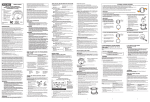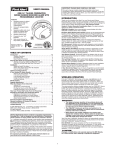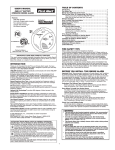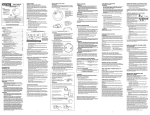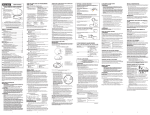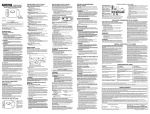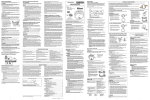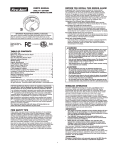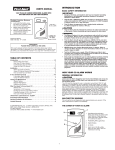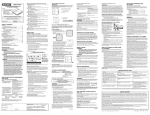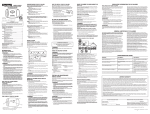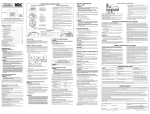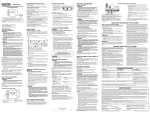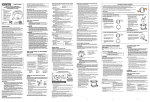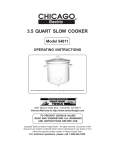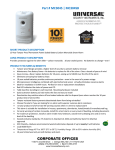Transcript
installation User’s Manual Where to install CO alarmS WIRELESS INTERCONNECT BATTERY OPERATED Carbon Monoxide Alarm Features: WIRELESS INTERCONNECT Enabled Voice with Programmable Location Two Latching Features Two Silence Features If your bedroom hallway is longer than 40 feet (12 meters), install a CO Alarm at BOTH ends of the hallway. Refer to state and local building codes for additional requirements. To permanently remove either locking pin, insert a flathead screwdriver between the locking pin and the lock, and pry the pin out of the lock. LIVING ROOM Thank you for choosing First Alert for your Carbon Monoxide Alarm needs. You have purchased a state-of-the-art Alarm designed to provide you with early warning of a carbon monoxide danger. Key features include: WIRELESS INTERCONNECT Enabled. Alarm automatically communicates with other WIRELESS INTERCONNECT enabled alarms when installed. Exclusive Voice Warning with Location will tell you the preprogrammed location of the initiating unit and danger detected. Programmable up to 11 locations (ex. “basement”). When alarms sounds, if programmed for basement it will say “Warning, evacuate, carbon monoxide in basement” along with all other installed WIRELESS INTERCONNECT Voice alarms. Spread Spectrum Horn Tone. Lower and varying horn frequency makes it easier for elderly with normal age related hearing loss to hear horn. Sweeps through the 2200 – 3400 Hz range. RF Interconnect. Reliable and secure radio frequency communication between alarms. 915MHz frequency with 65,000 security codes and 3 channel frequency hopping. Single Button Test/Silence eliminates confusion. Depending on what mode the alarm is in, pushing the button provides different functions such as testing the alarm, silencing the alarm, re-testing the alarm when in silence and clearing the Latching features. Two Silence Features. Temporarily silence low battery chirp for up to eight hours before replacing low battery or silence an unwanted alarm for several minutes. Two Latching Features. Alarm Latch: Easily identifies initiating alarm even after alarm condition has subsided. Low Battery Latch: Identifies which unit is in low battery condition. Perfect Mount System includes a gasketless base for easy installation and a mounting bracket that keeps the alarm secure over a wide rotation range to allow for perfect alignment. End of Life Signal. Provides audible confirmation alarm needs to be replaced. ® basic safety information • For added protection, install an additional CO Alarm at least 20 feet (6 meters) away from the furnace or fuel burning heat source. In a Multi-level Home: • Install at least one CO Alarm near or within each separate sleeping area. • For added protection, install at least one CO Alarm on each level of the home. If you have a basement, install that CO Alarm at the top of the basement stairs. • For added protection, install an additional CO Alarm at least 20 feet (6 meters) away from the furnace or fuel burning heat source. In Mobile Homes: • Install CO Alarms on inside walls ONLY. Uninsulated outside walls and roofs of mobile homes often transfer heat and cold from outdoors. • D angers, Warnings, and Cautions alert you to important operating instructions or to potentially hazardous situations. Pay special attention to these items. • This CO Alarm is approved for use in single-family residences. Do NOT locate this CO Alarm: • In garages, kitchens, furnace rooms, or in any extremely dusty, dirty or greasy areas. • Closer than 15 feet (4.6 meters) from a furnace or other fuel burning heat source, or fuel burning appliances like a water heater. • Within 5 feet (1.5 meters) of any cooking appliance. • In areas where temperature is colder than 40˚ F (4.4˚ C) or hotter than 100˚ F (37.8˚ C). These areas include non-airconditioned crawl spaces, unfinished attics, uninsulated or poorly insulated ceilings, porches, and garages. • In turbulent air, like near ceiling fans, heat vents, air conditioners, fresh air returns, or open windows. Blowing air may prevent CO from reaching the sensors. • In direct sunlight. • T he CO Alarm is not designed to detect fire or any other gas. It will only indicate the presence of carbon monoxide gas at the sensor. Carbon monoxide gas may be present in other areas. • T his CO Alarm cannot operate without working batteries. Removing the batteries for any reason, or failing to replace the batteries at the end of their service life, removes your protection. • NEVER ignore any alarm. See “If Your CO Alarm Sounds” for more information on how to respond to an alarm. Failure to respond can result in injury or death. • The Silence Features are for your convenience only and will not correct a problem. See “Using the Silence Features” for details. Always check your home for a potential problem after any alarm. Failure to do so can result in injury or death. • Test this CO Alarm once a week. If the Alarm ever fails to test correctly, have it replaced immediately! If the Alarm is not working properly, it cannot alert you to a problem. • This product is intended for use in ordinary indoor locations of family living units. It is not designed to measure CO levels in compliance with Occupational Safety and Health Administration (OSHA) commercial or industrial standards. Individuals with medical conditions that may make them more sensitive to carbon monoxide may consider using warning devices which provide audible and visual signals for carbon monoxide concentrations under 30 ppm. For additional information on carbon monoxide and your medical condition contact your physician. WIRELESS OPERATION First Alert® WIRELESS INTERCONNECT Technology is the easy, costeffective way to provide your family with whole-home safety. All WIRELESS INTERCONNECT Alarms communicate with each other without wires or connectors. When one Alarm sounds, they all sound. This provides your family with an earlier warning of potential danger, and gives you more time to react. The communication distance (range) between any two WIRELESS INTERCONNECT Alarms is typically 50 feet (15 meters) inside of a home. Some features of a home, such as the number of floors, number/size of rooms, furniture and types of building materials used may reduce the range of the Alarms. Examples include: suspended ceilings, ductwork, large metallic appliances (refrigerators) and metal studs. A feature of WIRELESS INTERCONNECT Alarms is that they operate as a mesh network. All Alarms will repeat any alarm signal that is received to all other WIRELESS INTERCONNECT Alarms. Interference from structural conditions can be overcome by adding additional Alarms to route the wireless signal around obstructions. • T he range and proper operation of any wireless device will vary depending on its surroundings. It is very important that each Alarm is tested individually before and after installation to make sure that all Alarms respond properly. • The WIRELESS INTERCONNECT Alarms are not to be used outdoors or to transmit between buildings. The Alarms will not communicate properly under these conditions. • Metal objects and metallic wallpaper may interfere with signals from wireless Alarms. Alarms should be tested after changes to your home such as remodeling, moving furniture, and with metal doors opened and closed. Your First Alert® WIRELESS INTERCONNECT CO Alarm will automatically communicate both potential fires and carbon monoxide presence with all other First Alert® WIRELESS INTERCONNECT Smoke/CO Alarms. FCC Compliance This equipment has been tested and found to comply with the limits for a Class B digital device, pursuant to Part 15 of the FCC rules. These limits are designed to provide reasonable protection against harmful interference in a residential installation. This equipment generates, uses and can radiate radio frequency energy and, if not installed and used in accordance with the instructions, may cause harmful interference to radio communications. However, there is no guarantee that the interference will not occur in a particular installation. If this equipment does cause harmful interference to radio or television reception, which can be determined by turning the equipment off and on, the user is encouraged to try to correct the interference by one or more of the following measures: • Reorient or relocate the receiving antenna. • Increase the separation between the equipment and receiver. • Connect the equipment into an outlet on a circuit different from that of the receiver. • Consult the dealer or an experienced radio or TV technician for help. Warning: Changes or modifications to the product, not expressly approved by First Alert / BRK Brands, Inc., could void the user’s authority to operate the equipment. This device complies with Part 15 of the FCC Rules. Operation is subject to the following two conditions: (1) this device may not cause harmful interference, and (2) this device must accept any interference received, including interference that may cause undesired operation. FCC ID: M7U5001L 1. Remove the CO Alarm from the mounting bracket. If the unit is locked to the bracket, see the section “To Unlock the Mounting Bracket.” If the unit does not alarm during testing, DO NOT lock the battery compartment! Install new batteries and test again. If the CO Alarm still does not alarm, replace it immediately. 2. Insert a flathead screwdriver under the head of the locking pin, and gently pry it out of the battery compartment lock. (If you plan to relock the battery compartment, save the locking pin.) • T his CO Alarm is designed for use inside a single-family home or apartment. It is not meant to be used in common lobbies, hallways, or basements of multi-family buildings unless working CO Alarms are also installed in each family living unit. CO Alarms in common areas may not be heard from inside individual family living units. • T his CO Alarm alone is not a suitable substitute for complete detection systems in places which house many people, like hotels or dormitories, unless a CO Alarm is also placed in each unit. • D O NOT use this CO Alarm in warehouses, industrial or commercial buildings, special-purpose non-residential buildings, RVs, boats, or airplanes. This CO Alarm is specifically designed for residential use, and may not provide adequate protection in non-residential applications. For quick installation instructions see the “Quick Installation Instructions” included. This CO Alarm was designed to be mounted on the ceiling or wall. It is not a tabletop device. You must install this device on the ceiling or wall as outlined below. Read “Where To Install CO Alarms” before starting. PARTS OF THIS CO ALARM 1Test/Silence Button 2Battery Compartment 3Power LED 4 CO Alarm LED Tools you will need: pencil, drill with 3/16” (5mm) drill bit, Phillips screwdriver, hammer. 1. Hold the mounting bracket against the ceiling (or wall) so the vertical mounting slot is aligned in the 12 o’clock position and trace around the inside of the mounting slots (vertical and horizontal mounting). 2. Put the unit where it won’t get covered with dust when you drill the mounting holes. 3. Using a 3/16” (5 mm) drill bit, drill a hole through the center of the oval outlines you traced. 4. Insert the plastic screw anchors (in the plastic bag with screws) into the holes. Tap the screw anchors gently with a hammer, if necessary, until they are flush with the ceiling or wall. 5. Line the mounting bracket up over the plastic screw anchors. 6. Screw the mounting bracket to the ceiling or wall through the mounting slots using the two screws provided. 7. Attach the CO Alarm to the mounting bracket. Line up the guides on the alarm’s base with the guides on the mounting bracket. When guides are lined up, turn the base clockwise (right) until it snaps into place. NOTE: Once the Alarm is snapped onto the mounting bracket, you can rotate the Alarm to adjust the alignment. 8. Test the CO Alarm. See “Weekly Testing” for details. STEP BY STEP GUIDE TO PROGRAMMING THIS ALARM For First Time and When Changing Batteries Action: 1. Insert batteries (2, AA batteries). Alarm Will Say: “Welcome, First Alert Carbon Monoxide Alarm.” “No location programmed” if first time or “[Location, example: “Basement”] location programmed” when changing batteries. “To select location, press and hold test button now.” “To save location, press and hold test button after location is heard.” Alarm will speak list of locations (see below). 2. P ress & Hold Test Button if you would like to program the location or change the location of the Alarm. Release button after Alarm responds. 3. After you hear the location of where you are placing the Alarm, Press & Hold the Test Button. “[Location, example: “Basement”] location saved.” If no location is chosen: “No location saved.” 2. Pry the CO Alarm away from the bracket by pushing up on the screwdriver and turning the CO Alarm counterclockwise (left) at the same time. 2. Press and hold the test button and then close the battery drawer. 3. Once you hear the unit chirp, release the test button. The Green power LED will start to blink indicating the WIRELESS INTERCONNECT Alarm is waiting for program data from one of the other setup WIRELESS INTERCONNECT Alarms. 4. Press and hold the test button on the first Alarm, until the second Alarm chirps and its Green power LED stops blinking. Then release the test button. 5. If you have purchased the hardwired battery back-up WIRELESS INTERCONNECT Alarm, you can now connect the hardwired Alarm by installing the three-wire connector on the ceiling to the Alarm. You have now successfully linked your new WIRELESS INTERCONNECT Alarms. To add additional Alarms at a later time, follow steps 1 through 5. WHAT YOU WILL SEE AND HEAR WITH THIS ALARM Under Normal Operations Voice: Silent Horn: Silent Power LED: Flashes Green once/minute When You Test the Alarm Voice: “Testing.” Horn: 4 fast beeps, pause, 4 fast beeps; Voice: “ Warning, evacuate carbon monoxide in [Location, example: “Basement”]. Evacuate.” Pause. “Highest carbon monoxide level was [CO level example: _0_ ppm]”. CO LED: Flashes Red in sync with the horn pattern If Battery Becomes Low or is Missing Voice: “ Replace battery in [Location, example “Basement”].” Repeated every 5 hours Horn: chirps once a minute Power LED: Flashes Green On for 2 seconds/Off for 2 seconds. Low Battery Latch is now engaged. If Alarm is Not Operating Properly (MALFUNCTION SIGNAL) Voice: “ Detector error in [Location, example “Basement”], please see manual.” Repeated every 5 hours Horn: 3 chirps every minute CO LED: 3 Flashes approximately once a minute Alarm has reached its End of Life Voice: “ Detector error in [Location, example “Basement”], please see manual.” Repeated every 5 hours Horn: 5 chirps every minute CO LED: 5 Flashes approximately once a minute Alarm Levels of CO are Detected Horn: 4 fast beeps, pause, 4 fast beeps, pause* Voice: “ Warning, evacuate carbon monoxide in [Location, example: “Basement”]. Evacuate.” Pause. “Highest carbon monoxide level was [CO level example: ___ ppm]”. Horn: 4 beeps, pause, 4 beeps, pause repeating 2 times followed by Voice Warning above. CO LED: During Alarm: Flashes Red in sync with the horn pattern. After Alarm: Flashes Red On for 2 seconds/Off for 2 seconds. CO Alarm Latch is now engaged. *NOTE: If unit goes into CO alarm, the regular 4 beeps-brief pause cycle will repeat for fifteen minutes. After fifteen minutes, the pause will increase to one minute. CO Alarm is Silenced Horn: Off CO LED: Flashes Red If your co alarm sounds What You See and Hear • T est the CO Alarm once a week. If the CO Alarm ever fails to test properly, have it replaced immediately! If the CO Alarm is not working properly, it cannot alert you to a problem. • D O NOT stand close to the Alarm when the horn is sounding. Exposure at close range may be harmful to your hearing. When testing, step away when horn starts sounding. It is important to test this unit every week to make sure it is working properly. Using the test button is the recommended way to test this CO Alarm. You can test this CO Alarm by pressing and holding the Test/Silence button on the Alarm cover (typically 3-5 seconds). During testing, you will see and hear the following sequence: • T he Horn will sound 4 beeps, pause, 4 beeps. The Power LED will be Off and the CO LED flashes Red. If the unit does not alarm, make sure the batteries are correctly installed, and test again. If the unit still does not alarm, replace it immediately. Keep battery out of reach of children. In the event a battery is swallowed, immediately contact your poison control center, your physician, or the National Battery Ingestion hotline at 202-625-3333 as serious injury may occur. Actual battery service life depends on the CO Alarm and the environment in which it is installed. All the batteries specified above are acceptable replacement batteries for this unit. Regardless of the manufacturer’s suggested battery life, you MUST replace the battery immediately once the unit starts “chirping” (the “low battery warning”). To replace the batteries (without removing Alarm from the ceiling or wall): 1. Open the battery compartment. 2. Press tabs A and B as shown in the diagram and remove each battery. 3. Insert the new batteries, making sure they snap completely into the battery compartment. Match the terminals on the ends of the batteries with the terminals on the unit. What you need to know about co What is CO? Actuation of your CO Alarm indicates the presence of carbon monoxide (CO) which can kill you. In other words, when your CO Alarm sounds, you must not ignore it! These fuels include: Wood, coal, charcoal, oil, natural gas, gasoline, kerosene, and propane. If the alarm SIGNAL sounds 1. Operate the Test/Silence button. 2. Call your emergency services, fire department or 911. Write down the number of your local emergency service here: ________________________________________________________________ 3. Immediately move to fresh air—outdoors or by an open door or window. Do a head count to check that all persons are accounted for. Do not re-enter the premises, or move away from the open door or window until the emergency services responder has arrived, the premises have been aired out, and your CO Alarm remains in its normal condition. 4. After following steps 1-3, if your CO Alarm reactivates within a 24-hour period, repeat steps 1-3 and call a qualified appliance technician to investigate for sources of CO from fuel-burning equipment and appliances, and inspect for proper operation of this equipment. If problems are identified during this inspection have the equipment serviced immediately. Note any combustion equipment not inspected by the technician, and consult the manufacturers’ instructions, or contact the manufacturers directly, for more information about CO safety and this equipment. Make sure that motor vehicles are not, and have not, been operating in an attached garage or adjacent to the residence. Write down the number of a qualified appliance technician here: ________________________________________________________________ Alarms have various limitations. See “General Limitations of CO Alarms” for details. “ALARM—MOVE TO FRESH AIR” If you hear the CO alarm horn and the CO red light is flashing, move everyone to a source of fresh air. DO NOT remove the batteries! Using the Silence Features CO is an invisible, odorless, tasteless gas produced when fossil fuels do not burn completely, or are exposed to heat (usually fire). Electrical appliances typically do not produce CO. Common appliances are often sources of CO. If they are not properly maintained, are improperly ventilated, or malfunction, CO levels can rise quickly. CO is a real danger now that homes are more energy efficient. “Air-tight” homes with added insulation, sealed windows, and other weatherproofing can “trap” CO inside. Symptoms of CO Poisoning These symptoms are related to CO POISONING and should be discussed with ALL household members. Mild Exposure: Slight headache, nausea, vomiting, fatigue (“flu-like” symptoms). Medium Exposure: Throbbing headache, drowsiness, confusion, fast heart rate. Extreme Exposure: Convulsions, unconsciousness, heart and lung failure. Exposure to Carbon Monoxide can cause brain damage, death. Some individuals are more sensitive to CO than others, including people with cardiac or respiratory problems, infants, unborn babies, pregnant mothers, or elderly people can be more quickly and severely affected by CO. Members of sensitive populations should consult their doctors for advice on taking additional precautions. Finding the Source of CO After an Alarm Carbon monoxide is an odorless, invisible gas, which often makes it difficult to locate the source of CO after an alarm. These are a few of the factors that can make it difficult to locate sources of CO: • House well ventilated before the investigator arrives. • Problem caused by “backdrafting.” • Transient CO problem caused by special circumstances. Because CO may dissipate by the time an investigator arrives, it may be difficult to locate the source of CO. BRK Brands, Inc. shall not be obligated to pay for any carbon monoxide investigation or service call. Potential Sources Of CO In The Home Never remove the batteries to quiet an unwanted alarm. Removing the batteries disables the alarm and removes your protection. When the CO Alarm is Silenced the CO Alarm will remain silent for up to 4 minutes. After 4 minutes, if CO levels remain potentially dangerous the horn will start sounding again. Once the low battery warning “chirp” silence feature is activated, the unit continues to flash the Green light twice a minute for 8 hours. After 8 hours, the low battery “chirp” will resume. Replace the batteries as soon as possible; this unit will not operate without battery power! To deactivate this feature: Press the Test/Silence button again. The unit will go into Test Mode and the low battery warning will resume (LED flashes and unit sounds “chirp” once a minute). This silence feature can temporarily quiet the End of Life warning “chirp” for up to 2 days. You can silence the End of Life warning “chirp” by pressing the Test/Silence button. The horn will chirp, acknowledging that the End of Life silence feature has been activated. After approximately 2 days, the End of Life “chirp” will resume. Latching FEATURES Alarm Latch is activated after an Alarm is exposed to alarm levels of carbon monoxide. After CO levels drop below alarm levels, the “CO” Red LED will begin to flash On for 2 seconds/Off for 2 seconds. It will continue to flash or “latch” for about 15 minutes, to give you time to determine which unit initiated the alarm. Low Battery Latch is activated when the Alarm is in the “low battery condition”. When this occurs, the Power LED flashes Green On for 2 seconds/ Off for 2 seconds for about 15 minutes. This feature is designed to help you identify which Alarm needs to have the battery replaced. Although, the Alarm will sound the low battery chirp approximately once every minute, sometimes during the initial stages of “low battery”, the Alarm will chirp in greater intervals than one minute, sometimes up to several hours, until the battery reaches a steady low battery level. This innovative feature eliminates the frustration of waiting for and/or identifying which unit is chirping. A CO Alarm is an excellent means of protection. It monitors the air and sounds a loud alarm before Carbon Monoxide levels become threatening for average, healthy adults. A CO Alarm is not a substitute for proper maintenance of home appliances. To help prevent CO problems and reduce the risk of CO poisoning: • C lean chimneys and flues yearly. Keep them free of debris, leaves, and nests for proper air flow. Also, have a professional check for rust and corrosion, cracks, or separations. These conditions can prevent proper air movement and cause backdrafting. Never “cap” or cover a chimney in any way that would block air flow. • T est and maintain all fuel-burning equipment annually. Many local gas or oil companies and HVAC companies offer appliance inspections for a nominal fee. • M ake regular visual inspections of all fuel-burning appliances. Check appliances for excessive rust and scaling. Also check the flame on the burner and pilot lights. The flame should be blue. A yellow flame means fuel is not being burned completely and CO may be present. Keep the blower door on the furnace closed. Use vents or fans when they are available on all fuel-burning appliances. Make sure appliances are vented to the outside. Do not grill or barbecue indoors, or in garages or on screen porches. • C heck for exhaust backflow from CO sources. Check the draft hood on an operating furnace for a backdraft. Look for cracks on furnace heat exchangers. • C heck the house or garage on the other side of shared wall. • K eep windows and doors open slightly. If you suspect that CO is escaping into your home, open a window or a door. Opening windows and doors can significantly decrease CO levels. In addition, familiarize yourself with all enclosed materials. Read this manual in its entirety, and make sure you understand what to do if your CO Alarm sounds. Regulatory information for co alarms Underwriters Laboratories Inc. UL2034 WHAT LEVELS OF CO CAUSE AN ALARM? Underwriters Laboratories Inc. Standard UL2034 requires residential CO Alarms to sound when exposed to levels of CO and exposure times as described below. They are measured in parts per million (ppm) of CO over time (in minutes). UL2034 Required Alarm Points*: • If the alarm is exposed to 400 ppm of CO, IT MUST ALARM BETWEEN 4 and 15 MINUTES. • If the alarm is exposed to 150 ppm of CO, IT MUST ALARM BETWEEN 10 and 50 MINUTES. • If the alarm is exposed to 70 ppm of CO, IT MUST ALARM BETWEEN 60 and 240 MINUTES. * Approximately 10% COHb exposure at levels of 10% to 95% Relative Humidity (RH). The unit is designed not to alarm when exposed to a constant level of 30 ppm for 30 days. CO Alarms are designed to alarm before there is an immediate life threat. Since you cannot see or smell CO, never assume it’s not present. • An exposure to 100 ppm of CO for 20 minutes may not affect average, healthy adults, but after 4 hours the same level may cause headaches. • An exposure to 400 ppm of CO may cause headaches in average, healthy adults after 35 minutes, but can cause death after 2 hours. This CO Alarm measures exposure to CO over time. It alarms if CO levels are extremely high in a short period of time, or if CO levels reach a certain minimum over a long period of time. The CO Alarm generally sounds an alarm before the onset of symptoms in average, healthy adults. Why is this important? Because you need to be warned of a potential CO problem while you can still react in time. In many reported cases of CO exposure, victims may be aware that they are not feeling well, but become disoriented and can no longer react well enough to exit the building or get help. Also, young children and pets may be the first affected. The average healthy adult might not feel any symptoms when the CO Alarm sounds. However, people with cardiac or respiratory problems, infants, unborn babies, pregnant mothers, or elderly people can be more quickly and severely affected by CO. If you experience even mild symptoms of CO poisoning, consult your doctor immediately! Standards: Underwriters Laboratories Inc. Single and Multiple Station carbon monoxide alarms UL2034. According to Underwriters Laboratories Inc. UL2034, Section 1-1.2: “Carbon monoxide alarms covered by these requirements are intended to respond to the presence of carbon monoxide from sources such as, but not limited to, exhaust from internal-combustion engines, abnormal operation of fuelfired appliances, and fireplaces. CO Alarms are intended to alarm at carbon monoxide levels below those that could cause a loss of ability to react to the dangers of Carbon Monoxide exposure.” This CO Alarm monitors the air at the Alarm, and is designed to alarm before CO levels become life threatening. This allows you precious time to leave the house and correct the problem. This is only possible if Alarms are located, installed, and maintained as described in this manual. Gas Detection at Typical Temperature and Humidity Ranges: The CO Alarm is not formulated to detect CO levels below 30 ppm typically. UL tested for false alarm resistance to Methane (500 ppm), Butane (300 ppm), Heptane (500 ppm), Ethyl Acetate (200 ppm), Isopropyl Alcohol (200 ppm) and Carbon Dioxide (5000 ppm). Values measure gas and vapor concentrations in parts per million. Audible Alarm: 85 dB minimum at 10 feet (3 meters). General Limitations Of co Alarms This CO Alarm is intended for residential use. It is not intended for use in industrial applications where Occupational Safety and Health Administration (OSHA) requirements for carbon monoxide detectors must be met. CO alarms may not waken all individuals. If children or others do not readily waken to the sound of the CO alarm, or if there are infants or family members with mobility limitations, make sure that someone is assigned to assist them in the event of an emergency. CO Alarms will not work without power. This alarm requires a two (2) AA batteries to operate. CO Alarms for Solar or Wind Energy users and battery backup power systems: AC powered CO Alarms should only be operated with true or pure sine wave inverters. Operating this Alarm with most battery-powered UPS (uninterruptible power supply) products or square wave or “quasi sine wave” inverters will damage the Alarm. If you are not sure about your inverter or UPS type, please consult with the manufacturer to verify. This CO Alarm will not sense carbon monoxide that does not reach the sensor. This CO Alarm will only sense CO at the sensor. CO may be present in other areas. Doors or other obstructions may affect the rate at which CO reaches the CO Alarm. For this reason, if bedroom doors are usually closed at night, we recommend you install a CO Alarm in each bedroom and in the hallway between them. CO Alarms may not sense CO on another level of the home. For example, a CO Alarm on the second level, near the bedrooms, may not sense CO in the basement. For this reason, one CO Alarm may not give adequate warning. Complete coverage is recommended. Place CO Alarms on each level of the home. CO Alarms may not be heard. The alarm horn loudness meets or exceeds current UL standards of 85 dB at 10 feet (3 meters). However, if the CO Alarm is installed outside the bedroom, it may not wake up a sound sleeper or one who has recently used drugs or has been drinking alcoholic beverages. This is especially true if the door is closed or only partly open. Even persons who are awake may not hear the alarm horn if the sound is blocked by distance or closed doors. Noise from traffic, stereo, radio, television, air conditioner, or other appliances may also prevent alert persons from hearing the alarm horn. This CO Alarm is not intended for people who are hearing impaired. CO Alarms are not a substitute for a smoke alarm. Although fire is a source of carbon monoxide, this CO Alarm does not sense smoke or fire. This CO Alarm senses CO that may be escaping unnoticed from malfunctioning furnaces, appliances, or other sources. Early warning of fire requires the installation of smoke alarms. CO Alarms are not a substitute for life insurance. Though these CO Alarms warn against increasing CO levels, BRK Brands, Inc. does not warrant or imply in any way that they will protect lives from CO poisoning. Homeowners and renters must still insure their lives. CO Alarms have a limited life. Although the CO Alarm and all of its parts have passed many stringent tests and are designed to be as reliable as possible, any of these parts could fail at any time. Therefore, you must test your CO Alarm weekly. CO Alarms are not foolproof. Like all other electronic devices, CO Alarms have limitations. They can only detect CO that reaches their sensors. They may not give early warning to rising CO levels if the CO is coming from a remote part of the home, away from the CO Alarm. troubleshooting guide If the Alarm... Problem... Horn “chirps” about once per minute. Low battery warning. You should... Install two new AA batteries*. Horn sounds three “chirps” every minute; LED has 3 flashes with “chirps”. malfunction signal. Device is not working properly, and needs to be replaced. Units under warranty should be returned to manufacturer for replacement. See “Limited Warranty” for details. The light flashes (RED) and the horn sounds 5 “chirps” every minute; Voice: “Detector error in [Location, example “Basement”], please see manual” repeated every 5 hours. END OF LIFE SIGNAL. CO Alarm needs to be replaced. Immediately replace the CO Alarm. The Alarms are linked but do not communicate with each other. Operation section of this manual. signal around obstructions. Possible interference. Reference the Wireless CO Alarm goes back into alarm 4 minutes after you Silence it. Move Alarms to different locations. Add an additional Alarm between the unresponsive Alarms to route the CO levels indicate a potentially dangerous situation. CO Alarm sounds frequently even though no high levels of CO are revealed in an investigation. The CO Alarm may be improperly located. Refer to “Where to Install CO Alarms” for details. IF YOU ARE FEELING SYMPTOMS OF CO POISONING, EVACUATE your home and call 911 or the Fire Department. Refer to “If The CO Alarm Sounds” for details. Relocate your Alarm. If frequent alarms continue, have home rechecked for potential CO problems. You may be experiencing an intermittent CO problem. Limited Warranty After the Test/Silence button is released, the Red LED blinks during the silence mode. This silence feature can temporarily quiet the low battery warning “chirp” for up to 8 hours. You can silence the low battery warning “chirp” by pressing the Test/Silence button on the alarm cover. Regulatory Information for CO Alarms, Continued If you have questions that cannot be answered by reading this manual, call Consumer Affairs at 1-800-323-9005, M-F 7:30 a.m. to 5:00 p.m. (CST) The Silence Feature can temporarily quiet an unwanted alarm for several minutes. You can silence this Alarm by pressing the Test/Silence button on the alarm cover for at least 3-5 seconds. Silencing The Low Battery Warning how can i protect my family From co poisoning? *For a list of acceptable replacement batteries, see “Regular Maintenance.” The Silence Feature is intended to temporarily silence the horn while you identify and correct the problem. Do not use the Silence Feature in emergency situations. It will not correct a CO problem. Fuel-burning appliances like: portable heater, gas or wood burning fireplace, gas kitchen range or cooktop, gas clothes dryer. Damaged or insufficient venting: corroded or disconnected water heater vent pipe, leaking chimney pipe or flue, or cracked heat exchanger, blocked or clogged chimney opening. Improper use of appliance/ device: operating a barbecue grill or vehicle in an enclosed area (like a garage or screened porch). Transient CO Problems: “transient” or on-again-off-again CO problems can be caused by outdoor conditions and other special circumstances. The following conditions can result in transient CO situations: BRK Brands, Inc., (“BRK”) the maker of First Alert® brand products warrants that for a period of seven years from the date of purchase, this product will be free from defects in material and workmanship. BRK, at its option, will repair or replace this product or any component of the product found to be defective during the warranty period. Replacement will be made with a new or remanufactured product or component. If the product is no longer available, replacement may be made with a similar product of equal or greater value. This is your exclusive warranty. This warranty is valid for the original retail purchaser from the date of initial retail purchase and is not transferable. Keep the original sales receipt. Proof of purchase is required to obtain warranty performance. BRK dealers, service centers, or retail stores selling BRK products do not have the right to alter, modify or any way change the terms and conditions of this warranty. This warranty does not cover normal wear of parts or damage resulting from any of the following: negligent use or misuse of the product, use on improper voltage or current, use contrary to the operating instructions, disassembly, repair or alteration by anyone other than BRK or an authorized service center. Further, the warranty does not cover Acts of God, such as fire, flood, hurricanes and tornadoes or any batteries that are included with this unit. 1. Excessive spillage or reverse venting of fuel appliances caused by outdoor conditions such as: • W ind direction and/or velocity, including high, gusty winds. Heavy air in the vent pipes (cold/humid air with extended periods between cycles). • N egative pressure differential resulting from the use of exhaust fans. • S everal appliances running at the same time competing for limited fresh air. • V ent pipe connections vibrating loose from clothes dryers, furnaces, or water heaters. • O bstructions in or unconventional vent pipe designs which can amplify the above situations. 2. Extended operation of unvented fuel burning devices (range, oven, fireplace). 3. Temperature inversions, which can trap exhaust close to the ground. 4. Car idling in an open or closed attached garage, or near a home. These conditions are dangerous because they can trap exhaust in your home. Since these conditions can come and go, they are also hard to recreate during a CO investigation. Your Alarm has now been programmed for the location of your choice. Available locations: Basement Kitchen Child’s Bedroom Living Room Dining Room Master Bedroom Family Room No Location Guest Bedroom Office Hallway Utility Room BRK shall not be liable for any incidental or consequential damages caused by the breach of any express or implied warranty. Except to the extent prohibited by applicable law, any implied warranty of merchantability or fitness for a particular purpose is limited in duration to the duration of the above warranty. Some states, provinces or jurisdictions do not allow the exclusion or limitation of incidental or consequential damages or limitations on how long an implied warranty lasts, so the above limitations or exclusion may not apply to you. This warranty gives you specific legal rights, and you may also have other rights that vary from state to state or province to province. How to Obtain Warranty Service Service: If service is required, do not return the product to your retailer. In order to obtain warranty service, contact the Consumer Affairs Division at 1-800-323-9005, 7:30 AM - 5:00 PM Central Standard Time, Monday through Friday. To assist us in serving you, please have the model number and date of purchase available when calling. For Warranty Service return to: BRK Brands, Inc., 25 Spur Drive, El Paso, TX 79906 Battery: BRK Brands, Inc. make no warranty, express or implied, written or oral, including that of merchantability or fitness for any particular purpose with respect to battery. TABLE OF CONTENTS For your records, please record: Date Purchased: _______________________________ Where Purchased: ____________________________________________ Date Installed: ____________/____________Month/Year Replace alarm 7 years after installation. Please write the date in the space provided: _____________/____________Month/Year The alarm will also provide an audible End-of-Life Signal approximately 7 years after installation to remind you to replace the unit. The End-of-Life Signal can be silenced for up to 2 days. Do not unplug the alarm or remove the batteries until you get replacement. First Alert® is a registered trademark of the First Alert Trust used under license. WIRELESS INTERCONNECT is a trademark of BRK Brands, Inc. Changes or modifications not expressly approved by BRK Brands, Inc. could void the user’s authority to operate the equipment. 1 AB Refer to section “What You Will See and Hear With This Alarm”. SILENCING THE END OF LIFE SIGNAL Weekly Testing • Always use the exact batteries specified by this User’s Manual. DO NOT use rechargeable batteries. Clean the battery contacts and also those of the device prior to battery installation. Install batteries correctly with regard to polarity (+ and -). Please dispose of or recycle used batteries properly, following any local regulations. Consult your local waste management authority or recycling organization to find an electronics recycling facility in your area. DO NOT DISPOSE OF BATTERIES IN FIRE. BATTERIES MAY EXPLODE OR LEAK. 4. Close the battery compartment, and then test the unit by pressing the Test/ Silence button. ADDING AND LINKING ADDITIONAL WIRELESS INTERCONNECT AlarmS • • 1. Insert a flathead screwdriver into the rectangular cut-out on the mounting bracket nearest to the locking pin. NOTE: Steps 1 through 3 need to be completed within two minutes. If more than two minutes pass, the Green power LED will stop blinking. Simply open the battery drawer of the second Alarm and repeat steps 1 through 3. 1. Insert the batteries into the battery drawer of the next Alarm. DO NOT CLOSE THE DRAWER. Choosing a replacement battery: Your CO Alarm requires two standard AA batteries. The following batteries are acceptable as replacements: Duracell MN1500. These batteries are available at many local retail stores. When replacing the batteries, always test the Alarm before relocking the battery compartment. 1. Using needle-nose pliers, detach one locking pin from the mounting bracket. 3. When you attach the CO Alarm to the mounting bracket, the locking pin’s head will fit into a notch on the bracket. This unit has been designed to be as maintenance-free as possible, but there are a few simple things you must do to keep it working properly. • Test it at least once a week. • Clean the CO Alarm at least once a month; gently vacuum the outside of the CO Alarm using your household vacuum’s soft brush attachment. A can of clean compressed air (sold at computer or office supply stores) may also be used. Follow manufacturer instructions for use. Test the CO Alarm. Never use water, cleaners or solvents since they may damage the unit. • If the CO Alarm becomes contaminated by excessive dirt, dust and/or grime, and cannot be cleaned to avoid unwanted alarms, replace the unit immediately. • Relocate the unit if it sounds frequent unwanted alarms. See “Where CO Alarms Should Not Be Installed” for details. 4. Reattach the CO Alarm to the mounting bracket. To UnLock The Mounting Bracket 6. Repeat steps 1-5 for additional WIRELESS INTERCONNECT Alarms. How to Install This Alarm 3. To relock the battery compartment, close the battery door and reinsert locking pin in lock. To Lock The Mounting Bracket 2. Insert the locking pin through the hole on the back of the CO Alarm as shown in the diagram. Where CO AlarmS should NOT be Installed Do not lock the battery compartment until you install the batteries and test the CO Alarm. 2. After batteries are inserted, then push the locking pin through the hole near the battery door latch on the back of the CO Alarm. In a Single-level Home: • Install at least one CO Alarm near or within each separate sleeping area. © 2014 BRK Brands, Inc. All rights reserved. Distributed by BRK Brands, Inc. 3901 Liberty Street Road, Aurora, IL 60504-8122 Consumer Affairs: (800) 323-9005 • www.firstalert.com To UnLock The Battery Compartment 1. Using needle-nose pliers, detach one locking pin from the mounting bracket. SUGGESTED AREAS FOR INSTALLING ADDITIONAL CO ALARMS INTRODUCTION To Lock The Battery Compartment GARAGE REQUIRED TO MEET NFPA RECOMMENDATIONS Model CO511 KITCHEN HALL BEDROOM BASEMENT UL STD 2034 BEDROOM BEDROOM CONFORMS TO The optional locking features are designed to prevent unauthorized removal of the battery or alarm. It is not necessary to activate the locks in single-family households where unauthorized battery or alarm removal is not a concern. These CO Alarms have two separate locking features: one to lock the battery compartment, and the other to lock the CO Alarm to the mounting bracket. You can choose to use either feature independently, or use them both. Tools you will need: • Needle-nose pliers • Standard flathead screwdriver. Both locking features use locking pins, which are molded into the mounting bracket. Depending on which locking features you use, remove one or both pins from the mounting bracket using needle-nose pliers. The National Fire Protection Association (NFPA) recommends that a CO Alarm should be centrally located outside of each separate sleeping area in the immediate vicinity of the bedrooms. For added protection, install additional CO Alarms in each separate bedroom, and on every level of your home. IMPORTANT! PLEASE READ CAREFULLY AND SAVE. This user’s manual contains important information about your Carbon Monoxide Alarm’s operation. If you are installing this Alarm for use by others, you must leave this manual—or a copy of it—with the end user. M08-0195-004 Q 09/14 Printed in Mexico regular maintenance Optional Locking Features Introduction. . . . . . . . . . . . . . . . . . . . . . . . . . . . . . . . . . . . . . . . . . . . . . . . . . . 1 Basic Safety Information. . . . . . . . . . . . . . . . . . . . . . . . . . . . . . . . . . . . . 1 Wireless Operation. . . . . . . . . . . . . . . . . . . . . . . . . . . . . . . . . . . . . . . . . . . . . 1 Installation. . . . . . . . . . . . . . . . . . . . . . . . . . . . . . . . . . . . . . . . . . . . . . . . . . . . 2 Where to Install CO Alarms. . . . . . . . . . . . . . . . . . . . . . . . . . . . . . . . . . . 2 Where CO Alarms Should NOT Be Installed. . . . . . . . . . . . . . . . . . . . . . 2 How to Install This Alarm. . . . . . . . . . . . . . . . . . . . . . . . . . . . . . . . . . . . . 2 Step By Step Guide to Programming This Alarm. . . . . . . . . . . . . . . . . . .2-3 Adding and Linking Additional WIRELESS INTERCONNECT Alarms. . . 3 What You Will See and Hear With This Alarm. . . . . . . . . . . . . . . . . . . . . 3 Weekly Testing. . . . . . . . . . . . . . . . . . . . . . . . . . . . . . . . . . . . . . . . . . . . . . . . . 3 Optional Locking Features. . . . . . . . . . . . . . . . . . . . . . . . . . . . . . . . . . . . . 3-4 If Your CO Alarm Sounds. . . . . . . . . . . . . . . . . . . . . . . . . . . . . . . . . . . . . . . . 4 Using the Silence Features . . . . . . . . . . . . . . . . . . . . . . . . . . . . . . . . . . . 4 Latching Features . . . . . . . . . . . . . . . . . . . . . . . . . . . . . . . . . . . . . . . . . . 4 Regular Maintenance. . . . . . . . . . . . . . . . . . . . . . . . . . . . . . . . . . . . . . . . . . . 5 What You Need To Know About CO . . . . . . . . . . . . . . . . . . . . . . . . . . . . . . . 5 What is CO?. . . . . . . . . . . . . . . . . . . . . . . . . . . . . . . . . . . . . . . . . . . . . . . 5 Symptoms of CO Poisoning . . . . . . . . . . . . . . . . . . . . . . . . . . . . . . . . . . 5 Finding the Source of CO after an Alarm . . . . . . . . . . . . . . . . . . . . . . . . 5 Potential Sources of CO in the Home. . . . . . . . . . . . . . . . . . . . . . . . . . . 5 How Can I Protect My Family From CO Poisoning?. . . . . . . . . . . . . . . . . . 6 Regulatory Information For CO Alarms . . . . . . . . . . . . . . . . . . . . . . . . . . 6-7 Underwriters Laboratories Inc. UL 2034. . . . . . . . . . . . . . . . . . . . . . . 6-7 General Limitations Of CO Alarms . . . . . . . . . . . . . . . . . . . . . . . . . . . . . . . . 7 Troubleshooting Guide. . . . . . . . . . . . . . . . . . . . . . . . . . . . . . . . . . . . . . . . 6-7 Limited Warranty. . . . . . . . . . . . . . . . . . . . . . . . . . . . . . . . . . . . . . . . . . . . . 6-7 Printed in Mexico M08-0195-004 Q 09/14 2 3 4 5 6 7
